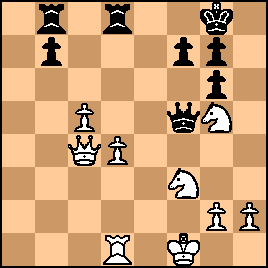| PawnSac: < mel gibson: Difficult but I did consider that move. 35. Rxg5 > White has nothing better.

click for larger viewThe pin on the Nf3 is problematic. If white does not play Rx, he must find some other improving move that answers black's threat of ..Nxf3 and I don't see a good one. But Rxg5! Bxg5 Ne4 fork doubles up on the B, so white wins a B + N for the R while also solving the pin problem. 
click for larger viewBut after the exchange we're at this position with black to move, and since we don't know what black will do, and since also nothing is forced, we simply have to wait and see what black does. So the puzzle is necessarily in 2 parts: 1. Get settled on Rxg5 as being best
(white has a strong center passer and 2 knights vs a rook in the middle game, with no obvious counter threats), so just trust your assessment of the position and play the exchange, then... 2. See what black plays, and find the win from there.
Otherwise, over the board your clock is running while you calculate endless possibilities. So 37. ..Rd5 is an obligatory freebee. After seeing blacks move, we can calculate further. 
click for larger viewBlack appears to be trying to block the white Q's diagonal, in order to play ..f6 kicking the knight. In this position I chose Re1 with the idea answering ..f6 with Re5! hitting the Q.
if then ..fxe5 Qxd5+ Kh8 white can gobble up another pawn if there's nothing better. but of course, it's a tricky position. I'd be watching for forks, and try to get a N on f7 to guard the d-pawn advance, or force a discovered check with a knight hop. | 




